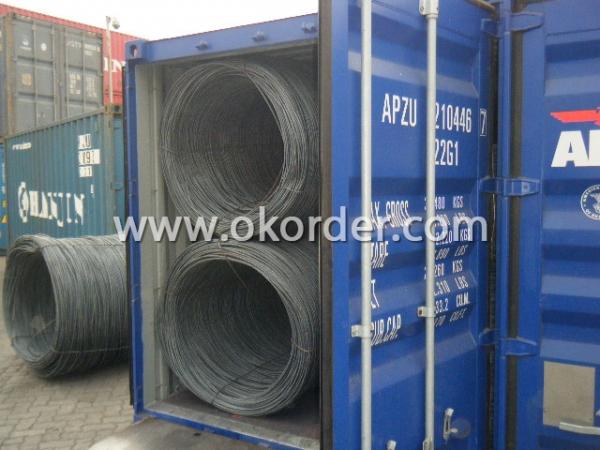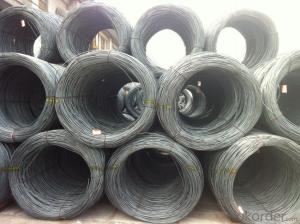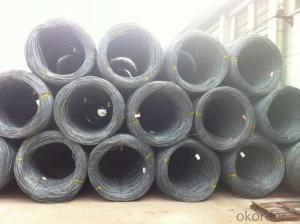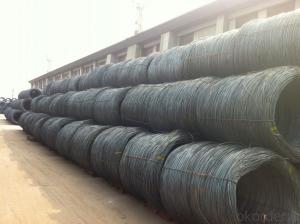High Quality Hot Rolled Wire Rod Carbon Steel
- Loading Port:
- Tianjin
- Payment Terms:
- TT OR LC
- Min Order Qty:
- 20 m.t.
- Supply Capability:
- 2000 m.t./month
OKorder Service Pledge
OKorder Financial Service
You Might Also Like
Product Description:
OKorder is offering Carbon Steel Wire Rod at great prices with worldwide shipping. Our supplier is a world-class manufacturer of steel, with our products utilized the world over. OKorder annually supplies products to European, North American and Asian markets. We provide quotations within 24 hours of receiving an inquiry and guarantee competitive prices.
Product Applications:
Carbon Steel Wire Rod are ideal for structural applications and are widely used in the construction of buildings and bridges, and the manufacturing, petrochemical, and transportation industries.After hot-rolled the products shaped into coil and delivery as finished product, including round, square, rectangular, hexagonal and so on. Since most of the products are round, it is generally called wire rod. Carbon steel wire rod is widely used in construction and manufacturing. Carbon steel wire rod is mainly used for reinforcement of reinforced concrete and welded structure or reprocessed (roberts , nail, etc.) materials, especially used to produce wire drawing, welding electrode, nails, spring, electronic, precise machinery parts and so on.
Product Advantages:
OKorder's Carbon Steel Wire Rod are durable, strong, and resist corrosion.
Main Product Features:
· Premium quality
· Prompt delivery & seaworthy packing (30 days after receiving deposit)
· Corrosion resistance
· Can be recycled and reused
· Mill test certification
· Professional Service
· Competitive pricing
Product Specifications:
Chemical Composition:
Please kindly find our chemistry of our material based on SAE1008B as below for your information
| Trademark | Rank | Chemical composition (quality score) % | ||||
| C | Si | Mn | S | P | ||
| ≤ | ≤ | ≤ | ||||
| Q195 | 0.06-0.12 | 0.30 | 0.25 | 0.050 | 0.045 | |
| Q235 | A | 0.14-0.22 | 0.30 | 0.30-0.65 | 0.050 | 0.045 |
| Q235 | B | 0.12-0.20 | 0.30 | 0.30-0.70 | 0.045 | 0.045 |
Packaging & Delivery of Wire Rod
Packaging Detail: products are packed in coil and then shipped by container or bulk vessel
Each coil weight: 2-3MT
Delivery Detail: within 45 days after received deposit or LC.
Label: to be specified by customer, generally, each bundle has 1-2 labels
Trade terms: CFR, CIF
Note:
1. Our products are produced according to national standard (GB), if not, supply according to national standards (GB) or agreement as customer required.
2. Other Grade and Standard carbon steel wire rod we can supply:
Grade: H08A, 30MnSi, 62B-82B
Standard: AISI, BS, JIS, DIN
The Minimum Order Quantity of these products is high, and need to be confirmed.
3. We can not only supply carbon steel wire rod; if you need anything about building materials, please contact us.
4. Please send us your detail specifications when inquire. We will reply to you as soon as possible. We sincerely hope we can establish a long stable business relationship.
FAQ:
Q1: Why buy Materials & Equipment from OKorder.com?
A1: All products offered byOKorder.com are carefully selected from China's most reliable manufacturing enterprises. Through its ISO certifications, OKorder.com adheres to the highest standards and a commitment to supply chain safety and customer satisfaction.
Q2: How do we guarantee the quality of our products?
A2: We have established an advanced quality management system which conducts strict quality tests at every step, from raw materials to the final product. At the same time, we provide extensive follow-up service assurances as required.
Q3: How soon can we receive the product after purchase?
A3: Within three days of placing an order, we will begin production. The specific shipping date is dependent upon international and government factors, but is typically 7 to 10 workdays.
Image


- Q:What are the common applications of alloy and oil tempered steel wire rod?
- Alloy and oil tempered steel wire rod are commonly used in a variety of applications due to their unique properties. One of the common applications of alloy tempered steel wire rod is in the manufacturing of automotive parts. The high strength and durability of this material make it ideal for use in components such as valve springs, suspension springs, and transmission gears. These parts need to withstand high levels of stress and fatigue, and alloy tempered steel wire rod provides the necessary qualities to ensure their longevity. Oil tempered steel wire rod, on the other hand, is commonly used in the production of springs. The oil tempering process enhances the wire's ability to resist deformation under heavy loads, making it suitable for applications where springs need to maintain their shape and functionality over time. This type of steel wire rod is commonly used in the manufacturing of springs for various industries including automotive, construction, and aerospace. Another application of alloy and oil tempered steel wire rod is in the production of wire ropes. The combination of high tensile strength and excellent fatigue resistance makes these materials ideal for use in wire ropes used in elevators, cranes, and other heavy-duty lifting equipment. The wire ropes made from alloy and oil tempered steel wire rod can withstand heavy loads and provide reliable performance in demanding environments. Additionally, alloy and oil tempered steel wire rod find applications in the construction industry. They are often used in the production of reinforcement bars for concrete structures. The high strength and corrosion resistance of these materials ensure the durability and longevity of the reinforced concrete, making it suitable for use in buildings, bridges, and other infrastructure projects. In summary, alloy and oil tempered steel wire rod have numerous common applications. They are widely used in the manufacturing of automotive parts, springs, wire ropes, and reinforcement bars for construction. These materials provide the necessary strength, durability, and performance required for these applications, making them essential components in various industries.
- Q:What are the different mechanical tests conducted on steel wire rod?
- Some of the different mechanical tests conducted on steel wire rod include tensile strength testing, hardness testing, impact testing, and bend testing. These tests help determine the strength, durability, and flexibility of the steel wire rod, ensuring it meets the required specifications and standards for various applications.
- Q:How is steel wire rod used in the production of wire mesh for automotive filters?
- Steel wire rod is used in the production of wire mesh for automotive filters by being drawn into thin wires, which are then woven together to create a durable and strong mesh structure. This wire mesh acts as a filter by trapping and preventing contaminants from entering the automotive system, ensuring clean air and fluid flow for optimal performance and engine protection.
- Q:How is steel wire rod classified based on its chemical composition?
- Different grades or types are used to classify steel wire rod based on its chemical composition. The levels of carbon and alloying elements in the steel primarily determine this classification. Mild steel wire rod, also known as low carbon steel, typically contains a carbon content ranging from 0.05% to 0.25%. This type of steel is commonly used in general-purpose applications such as construction, automotive, and machinery. Wire rod made of medium carbon steel has a higher carbon content, usually between 0.25% and 0.60%. This grade of steel provides increased strength and hardness, making it suitable for applications that require higher tensile strength, like springs, wires, and cables. High carbon steel wire rod contains a carbon content of over 0.60%. This grade of steel is well-known for its exceptional strength and hardness. It is commonly used in the manufacturing of high-strength wires, guitar strings, and cutting tools. Alloy steel wire rod is composed of multiple alloying elements, including chromium, nickel, manganese, or molybdenum, in addition to carbon. These alloying elements enhance specific properties of the steel, such as corrosion resistance, heat resistance, or wear resistance. Alloy steel wire rod finds its applications in specialized fields like automotive components, fasteners, and machinery parts. To sum up, steel wire rod is classified based on its chemical composition. The varying levels of carbon and alloying elements determine its specific grade or type. This classification facilitates the selection of the appropriate steel wire rod for specific applications, taking into account the desired mechanical properties and performance requirements.
- Q:How is steel wire rod tested for wear resistance?
- Steel wire rod is tested for wear resistance using various methods. One common approach is the pin-on-disk test, where a small pin made of the wire rod material is rubbed against a rotating disk under controlled conditions. The weight loss or wear rate of the pin is measured to determine its resistance to wear. Other tests may include abrasion testing, where the wire rod is subjected to continuous rubbing against an abrasive surface, or impact testing, where the wire rod is struck repeatedly to evaluate its durability. These tests help assess the wear resistance of steel wire rods and ensure their suitability for specific applications.
- Q:What are the different types of steel wire rod surface defect detection methods?
- There are several types of steel wire rod surface defect detection methods, including visual inspection, magnetic particle inspection, ultrasonic testing, eddy current testing, and laser scanning. Each method has its own advantages and limitations, and the choice of method depends on the specific requirements of the industry and the type of defects being detected. Visual inspection is a basic method that relies on human observation, while magnetic particle inspection detects surface and near-surface defects using magnetic fields. Ultrasonic testing uses high-frequency sound waves to identify internal and external defects, while eddy current testing measures changes in electrical conductivity to detect surface defects. Laser scanning utilizes laser beams to create a detailed 3D image of the wire rod surface, allowing for precise defect detection.
- Q:What are the common standards for steel wire rod?
- The common standards for steel wire rod vary depending on the industry and the specific application. However, there are several widely recognized standards that are commonly followed in the steel wire rod manufacturing industry. One of the most widely accepted standards is the American Society for Testing and Materials (ASTM) standard. ASTM A510/A510M is the standard specification for general requirements for carbon and alloy steel wire rods and coarse round wire. This standard provides the general requirements for steel wire rods in terms of chemical composition, mechanical properties, dimensions, and tolerances. Another common standard is the International Organization for Standardization (ISO) standard. ISO 16120-2 specifies the general requirements for non-alloy steel wire rod for conversion to wire. This standard outlines the chemical composition, mechanical properties, and dimensions of non-alloy steel wire rods. In addition to these standards, there are also industry-specific standards for steel wire rod. For example, the automotive industry has its own set of standards that are followed by manufacturers to ensure the quality and performance of steel wire rods used in automotive applications. Overall, the common standards for steel wire rod include ASTM A510/A510M, ISO 16120-2, and industry-specific standards. These standards ensure that steel wire rods meet the necessary requirements for their intended applications and promote consistency and quality in the manufacturing process.
- Q:What are the major suppliers of steel wire rod?
- Some of the major suppliers of steel wire rod include ArcelorMittal, Nippon Steel Corporation, POSCO, Tata Steel, and Baosteel Group.
- Q:How is steel wire rod used in the production of wire for medical devices?
- Steel wire rod plays a critical role in producing wire for medical devices. It serves as the primary material that undergoes processing and transformation to become the final wire product used in various medical applications. The manufacturing process involves several steps, starting with the careful selection of high-quality steel wire rod. To ensure that the steel wire rod meets the strict requirements for medical devices, it is examined for its chemical composition, mechanical properties, and surface condition. These properties directly affect the wire's performance, strength, and resistance to corrosion and other environmental factors. Once the suitable steel wire rod is chosen, it goes through a series of manufacturing processes to convert it into wire for medical devices. These processes include cleaning, drawing, annealing, and coating. Cleaning removes any impurities or contaminants from the wire rod's surface, ensuring a clean and defect-free wire. Drawing is a crucial process where the steel wire rod is pulled through dies to gradually reduce its diameter, resulting in the desired thickness of the wire. This drawing process also enhances the wire's mechanical properties, such as tensile strength and flexibility, making it suitable for medical applications. After the drawing process, annealing is often performed to relieve any internal stresses accumulated during drawing and improve the wire's ductility. This step involves heating the wire to a specific temperature and then slowly cooling it. Annealing enhances the wire's flexibility and makes it more pliable for further processing. Coating is the final step in wire production for medical devices. Depending on the specific application, the wire may be coated with polymers or metals to provide additional protection against corrosion, improve biocompatibility, or enhance lubricity. The wire produced from steel wire rod is then used in the manufacturing of various medical devices, including catheters, guide wires, sutures, orthopedic implants, and stents. The high-quality steel wire rod ensures that the wire used in these devices meets the necessary standards of strength, flexibility, and durability required for medical use. In conclusion, steel wire rod is a crucial component in the production of wire for medical devices. Its careful selection and subsequent processing through cleaning, drawing, annealing, and coating result in a wire that meets the stringent requirements of medical applications. This wire is then utilized in the manufacturing of various medical devices, contributing to the advancement and improvement of healthcare worldwide.
- Q:What are the typical chemical compositions of steel wire rod?
- The typical chemical compositions of steel wire rods can vary depending on the specific grade and intended use of the wire rod. However, the most common elements found in steel wire rods are iron (Fe) and carbon (C). The percentage of carbon in steel wire rods usually ranges from 0.05% to 0.85%. In addition to iron and carbon, other elements are often added to steel wire rods to enhance specific properties. These elements include manganese (Mn), silicon (Si), sulfur (S), phosphorus (P), and sometimes chromium (Cr), nickel (Ni), and copper (Cu). Manganese is commonly added to improve the strength and hardenability of the wire rod. Silicon is added to enhance the steel's resistance to oxidation and improve its electrical properties. Sulfur and phosphorus are impurities that are usually restricted to low levels as they can negatively affect the steel's ductility and toughness. Chromium, nickel, and copper are sometimes added to steel wire rods to improve their resistance to corrosion or to enhance specific mechanical properties. These elements are commonly found in stainless steel wire rods, which are used in applications requiring high corrosion resistance. It is important to note that the exact chemical composition of steel wire rods may vary depending on the specific steelmaking process and any additional alloying elements or impurities present. Therefore, it is crucial to refer to the specifications or standards provided by the manufacturer to determine the precise chemical composition of a particular steel wire rod.
1. Manufacturer Overview |
|
|---|---|
| Location | |
| Year Established | |
| Annual Output Value | |
| Main Markets | |
| Company Certifications | |
2. Manufacturer Certificates |
|
|---|---|
| a) Certification Name | |
| Range | |
| Reference | |
| Validity Period | |
3. Manufacturer Capability |
|
|---|---|
| a)Trade Capacity | |
| Nearest Port | |
| Export Percentage | |
| No.of Employees in Trade Department | |
| Language Spoken: | |
| b)Factory Information | |
| Factory Size: | |
| No. of Production Lines | |
| Contract Manufacturing | |
| Product Price Range | |
Send your message to us
High Quality Hot Rolled Wire Rod Carbon Steel
- Loading Port:
- Tianjin
- Payment Terms:
- TT OR LC
- Min Order Qty:
- 20 m.t.
- Supply Capability:
- 2000 m.t./month
OKorder Service Pledge
OKorder Financial Service
Similar products
New products
Hot products
Related keywords





























